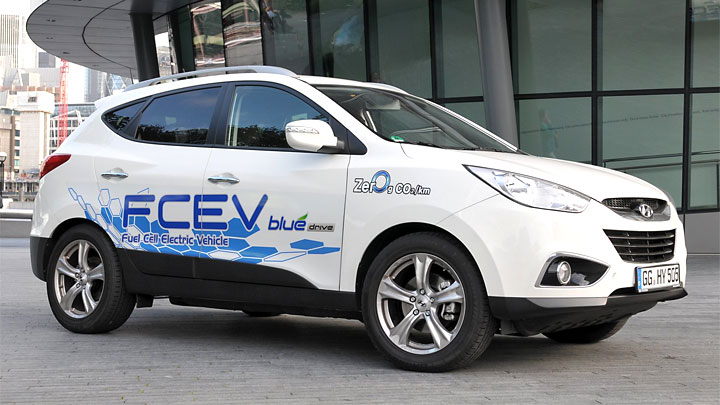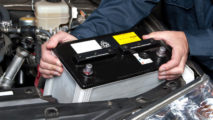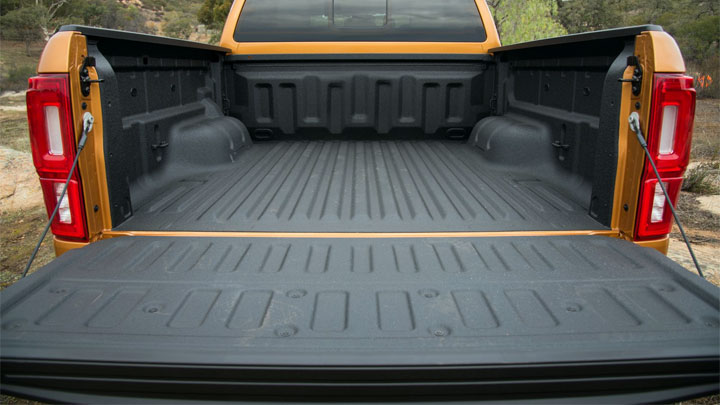Last Updated on November 26, 2021
The use of alternative energy for cars is becoming more popular in the modern age. While most people have heard of electric or hybrid vehicles, many don’t think about the energy sources available which can power them.
Out of all the electric car options that are available, hydrogen fuel cells have been proven to be some of the cleanest ones on the market. While they are not quite ready to become commonplace on today’s roads, the future is bright for hydrogen powered vehicles.
Keep reading to see how this technology works, its biggest pros and cons, and what the futures holds.
How a Hydrogen Fuel Cell Vehicle Works
Hydrogen fuel cell cars generate electricity through the conversion of hydrogen gas. Once this happens, heat and water are the only two things that emitted from it. Like with other electric vehicles, you won’t have any toxic carbon emissions being expelled into the atmosphere.
Within the vehicle are high-pressure fuel tanks which store the hydrogen gas. Instead of burning the gas like you do with normal fuel, the hydrogen gas flows into fuel cells which have oxygen in them.
The hydrogen gas then combines with the oxygen and forms the electric current necessary to power the electric motors. This, in turn, gives power to the wheels and allows the vehicle to move.
See Also: Pros/Cons of Hybrid Cars
Hydrogen Fuel Cell Advantages

Here are five advantages of a hydrogen fuel cell vehicle compared to a typical ICE (internal combustion engine) vehicle:
#1 – No Oil Needed
Since hydrogen is used as the fuel source, there is no need for traditional fuel sources like gas or oil.
#2 – Fewer Gas Emissions
Hydrogen only causes heat and water to be emitted from its tailpipe. You won’t find any carbon emissions coming out.
#3 – Better Fuel Efficiency
Fuel cell cars have been found to give drivers more miles per gallon than gas or diesel engine cars.
#4 – Silent Operation
Similar to other electric vehicles, the electrochemical reaction of fuel cells is mostly silent, unlike the process of burning fossil fuels.
#5 – Easy Maintenance
Fuel cell vehicles have fewer moving parts than regular vehicles. This makes them easier to maintain.
#6 – Small Battery
All vehicles have batteries in them, but they serve different purposes depending on the vehicle type. A hydrogen fuel cell car has a small battery pack which is responsible for increasing acceleration only. It is not the main energy source for propulsion like in hybrid vehicles.
Also, the hydrogen fuel cell car batteries are able to recharge themselves through the energy of the hydrogen fuel cells. This allows the batteries to last for a very long time.
Read Also: Hybrid Car Battery Life Expectancy
Hydrogen Fuel Cell Disadvantages

Here are the five biggest cons of a hydrogen fuel cell vehicle making them not yet ready to be a viable mainstream option.
#1 – Few Hydrogen Stations
The one big downside to hydrogen fuel cell cars is that you can’t just go to a traditional gas station to refill your tank. You will be required to go to a hydrogen fuel station to refuel the cells. Unfortunately, the number of operating hydrogen fuel stations is very limited.
In fact, there are only about 100 hydrogen fuel stations in the entire United States and the majority of them are in California. However, new estimates suggest over 4,000 hydrogen fueling stations to exist in the US by 2030.
#2 – Initial Cost
Fuel cell vehicles tend to be on the very expensive side since the fuel cell technology is still quite new and unique. You can expect to pay a minimum of $50,000 for the vehicle.
#3 – Low Durability
Compared to the durability of internal combustion engines, fuel cell systems are greatly lacking strong durability. This is especially true in humid environments.
#4 – Low Reliability
You will get about half the reliability from a fuel cell system that you would with an internal combustion engine.
#5 – Still Unknown
Fuel cell vehicles are still in the dark ages. The general public doesn’t even know what they are and there is little information about them available at most car dealerships.
Examples of Hydrogen Fuel Cell Vehicles

Honda and Toyota are two of the largest car companies in the world and they happen to utilize hydrogen fuel cell technology in a handful of their vehicles.
Since the beginning of the 21st century, Honda and Toyota have experimented with hydrogen fuel cell vehicle models. Most of them have remained in Japan while some were introduced in the United States as mere concept cars.
Here are 10 examples of vehicles with hydrogen fuel cell technology:
- 2017 Honda Clarity Fuel Cell – The 2017 Honda Clarity Fuel Cell is the latest fuel cell vehicle by Honda. In California, there are only 12 Honda dealerships which are approved to sell this model vehicle. Six of them are in Southern California.
- 2016 Honda Clarity Fuel Cell – The 2016 Honda Clarity Fuel Cell was introduced to the American market in Southern California since the last Clarity model in 2008. Now with more hydrogen fueling stations and dealerships to sell this vehicle, it allowed more people to become interested in buying it.
- 2015 Toyota Mirai – The 2015 Toyota Mirai is one of Toyota’s most popular hydrogen fuel cell vehicles. Priced at only $57,000, it is considered a luxury car and has since been sold in states all throughout the northeastern United States
- 2014 Honda FCV Concept– The 2014 Honda Fuel Cell Vehicle Concept showed American Californians what Honda was working on and what their fuel cell technology can do. This was only a concept car, but it led to the creation of their clarity models in 2016 and 2017.
- 2014 Toyota FCV – The 2014 Toyota Fuel Cell Vehicle was a concept car which was first shown at the Tokyo Motor Show before it was sold in the United States. It was only sold in areas where there were hydrogen fueling stations
- 2007 Honda FCX Clarity – The 2007 Honda Fuel Cell Experiment Clarity was the company’s new fuel cell vehicle which was introduced in Europe, Japan, and Southern California. Europe had already begun having hydrogen fueling stations at this point.
- 2005 Toyota Fine-X – The 2005 Toyota Fine-X, also known as Fuel Cell Innovation Emotion-eXperiment, started as a concept car at the Tokyo Motor Show and later at the Geneva Auto Show
- 2005 Toyota Fine-T – The 2005 Toyota Fine-T is actually another name for the Toyota Fine-X which was used in Europe and Japan. Both vehicles had very similar features and were some of the first to introduce four-wheel steering in a fuel cell vehicle.
- 2002 Honda FCX – The 2002 Honda Fuel Cell Experiment (FCX) was one of the first fuel cell vehicles produced by Honda. When it came out in 2002 it was actually a hybrid vehicle, but it was still the first to show off the true power of a hydrogen fuel tank.
- 2002 Toyota FCHV– The 2002 Toyota Fuel Cell Hybrid Vehicle was the first hydrogen vehicle introduced by Toyota. It was only available through a lease agreement to a limited number of American drivers. The response was encouraging but it would not get sold until years later.
Please Note: If you are interested in purchasing a hydrogen vehicle, you will need to research the locations of the nearest hydrogen fueling station. Since you can only drive within these areas, you won’t be able to take your hydrogen car on long trips where there are no fueling stations for it. That is why Honda and Toyota only chose certain dealerships to sell and lease these cars from. They wanted to be sure that consumers could access these fueling stations nearby.
The Outlook
You might wonder why more hydrogen vehicles are not being produced if they’re so great for the environment. The big argument from the other side is that hydrogen still causes emissions when it is produced.
This is technically true because hydrogen currently comes from natural gas. But we have the technology to produce hydrogen from cleaner renewables.
California has currently begun this process at 6 of their hydrogen fueling stations. The state requires that any hydrogen station which gets state funding must use renewable sources for a minimum of 33% of its hydrogen production. Hopefully, this percentage will increase in the future and spread to other states.




